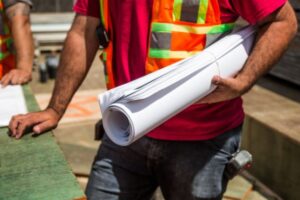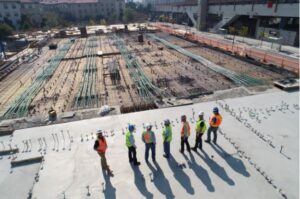
10 safety tips and advice for architecture construction projects
![]()
 Roughly 6.5 million Americans are on a construction site every single day. According to data from the Occupational Safety and Health Administration (OSHA), the construction industry is one of the deadliest globally, accounting for 21 percent of all workplace fatalities.
Roughly 6.5 million Americans are on a construction site every single day. According to data from the Occupational Safety and Health Administration (OSHA), the construction industry is one of the deadliest globally, accounting for 21 percent of all workplace fatalities.
OSHA recognizes four common causes of fatalities in the construction industry. Eliminating these “fatal four” hazards could save an average of 591 construction workers’ lives every year. These four hazards include:
- Falls — responsible for 33.5 percent of deaths
- Struck by objects — responsible for 11 percent of deaths
- Electrocutions — responsible for 8.5 percent of deaths
- Caught-in/between (objects, equipment, structures, etc.) — responsible for 5.5 percent of deaths
To mitigate these hazards and the other hazards associated with the construction industry, it’s essential to have a clear safety plan in mind. There are several tips and sound advice to ensure that all your architecture construction projects are safe.
Provide proper training regularly
 Training is essential in the construction industry. Many accidents could have been prevented with proper training. Too often, training is treated as a one-time task. Employees or contractors are trained one time when they’re hired and never undergo official training again.
Training is essential in the construction industry. Many accidents could have been prevented with proper training. Too often, training is treated as a one-time task. Employees or contractors are trained one time when they’re hired and never undergo official training again.
In the construction industry, training needs to be an ongoing part of working in this field. Training can be completed via hands-on training or formal courses and workshops. The important thing is that training is enforced and ongoing. Reframing the attitude around training can be the most significant difference-maker in increasing safety for architecture construction projects.
Minimize hazards
Other than training, there are 10 OSHA standards that construction sites are frequently cited for. Let’s get into each of these 10 hazards and discuss how you can prevent accidents in these accident-prone areas.
Scaffolding
Scaffolding presents significant falling hazards. Too often, scaffolding is poorly constructed and rickety. Solving for scaffolding-related injuries would prevent around 50 fatalities and 4,500 injuries each year.
To prevent scaffolding injuries and citations:
- Ensure the scaffolding is solid and capable of carrying four times the intended load without moving.
- Unstable objects shouldn’t be used to support planks or scaffolds.
- Scaffolding must have guardrails, handrails, mid-rails, and toeboards.
- Scaffolding should be inspected regularly at predetermined, regular intervals.
- Any rope used in scaffolding needs to be protected from heat.
- Scaffolding needs to be at least ten feet away from power lines.
Fall protection
Numerous things can cause falls. However, studies suggest that the inclusion of fall arrest systems, guard rails, covers and restraints systems, and safety nets can all significantly decrease injuries related to falls in the construction industry.
Excavations (general requirements)
Excavation and trenching are some of the most dangerous actions in the construction industry. Cave-ins are the most substantial risks. OSHA’s general requirements and rules for excavation and trenching are as follows:
- Keep equipment away from trench edges.
- Keep extra loads at least 2 feet from trench edges.
- Know where the utilities are located.
- Test for hazardous fumes, toxic gases, and low oxygen.
- Inspect trenches at the beginning of every shift.
- Examine trenches after a rainstorm.
- Do not work beneath raised loads.
Ladders
Shockingly, almost 25,000 injuries and 36 fatalities happen every year from falls on ladders and stairs. These injuries are probably some of the easiest to prevent. Ultimately, be sure to use the right ladder for the right job and throw away any broken ladders. Beyond that, don’t weigh down a ladder that has a limited capacity or use a ladder that isn’t high enough for the job. Also, remove paint and grease spots that could make ladders slippery.
Head protection
There’s a significant failure to enforce and wear hard hats. The risk of serious head injury is high in the construction industry. However, enforcing hard hats in dangerous areas could literally save a life.
Excavations (requirements for protective systems)
Excavations are so dangerous, and people do them incorrectly so often that they’re on this list of top 10 citations twice. When it comes to protective systems for excavations, there’s no shortage of safe options, including sloping, shoring and shielding.
However, designing a protective system can be complicated. You must consider the depth of cut, soil classification, the water content of the soil, changes due to weather or climate, extra loads and other operations in the vicinity.
Hazard communication
Hazard communication can relate to many things, but it’s often associated with dangerous chemical reactions and fire hazards. It’s imperative to maintain a material safety data sheet for each chemical on a given construction site. Additionally, have a spill plan in place and personal protective equipment available in case of spills.
Fall protection (training requirements)
Like excavation, fall protection is on here twice. Most fall protection lies in creating a safer environment. However, OSHA requires that workers are trained specifically on fall hazards. We’ve already touched on the importance of ongoing training but incorporating fall protection as part of the training is critical to reducing the number of falls on your future sites.
Construction (general safety and health provisions)
There are other OSHA general requirements for the construction industry that you should always be aware of. Most of them surround equipment and machinery maintenance and training. All equipment must be well-maintained and in good working order. Moreover, it’s pivotal that employees who operate machinery are trained to do so.
Providing adequate personal protective equipment for workers is also essential. If you run a construction site, it is your responsibility to keep your workers safe. They have the right to work in a safe and sanitary environment.
Electrical (wiring methods, design and protection)
It’s no surprise that electrical citations are common since electrocutions are one of the fatal four. Most of OSHA’s recommendations are based on common sense; for instance, don’t use damaged wires. There’s also a bit about making sure all equipment is within 10 feet of powerlines.
One of the best things you can do to maximize safety regarding electricity is to have a lockout/tagout (LOTO) procedure in place for shutting off hazardous machines and energy sources. This practice will ensure the highest degree of precaution.
Enforce environmental awareness through leadership
 Whether you specialize in concrete block homes or downtown skyscrapers, one thing is certain across the construction sector. Safety needs to be a top priority. To decrease hazards, you have to begin to enforce environmental awareness, and that paradigm shift starts as the top.
Whether you specialize in concrete block homes or downtown skyscrapers, one thing is certain across the construction sector. Safety needs to be a top priority. To decrease hazards, you have to begin to enforce environmental awareness, and that paradigm shift starts as the top.
Culture begins with leadership, and if your leadership is focused on environmental awareness, training and safety, your workers’ attitudes and culture will reflect that. To have safer architecture construction projects, you have to have an attitude and environment that promotes worker safety above all else.






